Kawah Ijen is a spectacular crater close to Banyuwangi on the east coast of Java in Indonesia. It is known for its huge turquoise acid crater lake and the “blue fire”.
Extremely hot sulfur emits flammable sulfuric gases. When they reach the surface, they react with oxygen and cause a bluish light that almost looks like blue lava. In order to see this spectacle, it must be pitch black dark.
The crater is also a place for suflur mining and a nearby refinery pays workers by the weight of sulfur transported. This is probably the main reason, why you are not allowed to enter the area during the day. Tourists shouldn’t disturb the workers in the sulfur mines.
They only let you enter after midnight. However it seems like you can stay for 24 hours once in the park. Many travel companies claim that you need a tour guide. This is not true – you definitely don’t need a guide!
Ticket Prices 2019:
Foreigners: Working Day Rp. 100,000 pp/24h
Holidays + Weekends Rp. 150,000 pp/24h
Locals: Working Day Rp. 5000 pp/24h
Holidays + Weekends: Rp. 7500 pp/24h
Don’t wonder – like everywhere in Indonesia, you have to pay unadequately more money as a foreigner than the locals do.
How was it?
When we arrived at Ijen region, it was afternoon and still way too early to be able to hike to the crater. Luckily there is a beautiful commercial hot spring ~16km northwest of Ijen in the little village Belawan. Although this place is a public bath, it is still worth spending some time there, since the area is very nice.
A few hours later it was dark and we wanted to start our hike, as we got told, that you can’t enter until midnight. So we had some food at the nearby restaurants a tried to have a nap, because we would only have a very short night.
We were still a little sleepy while waiting with many other tourists at the entrance gate shortly before midnight. They advised to rent gas masks due to sulfur vapours in the crater area. The crater rim of Mount Ijen is at 2386m. It is a steep hike and takes around 1,5 to 2 hours. You should bring head lights and warm clothes, because it is pitch black and the temperatures can drop really low. We only had 5°C.
In the first 3 kilometers the crowd was spread, but the last part into the crater ended in a huge queue of people. It was a very narrow path and among the many tourists, the miners were still carrying heavy baskets of sulfur.
Depending on the conditions it is not guaranteed that you can see the “blue fire”. However we were lucky that night. We could clearly see the blue glow between noisy columns of smoke and steam. In this area was an extreme smell of sulfur all around. We wouldn’t have needed the masks until this point, but they were useful to observe the blue fire. Despite these hundreds of tourists, it was a great spectacle.
A little bit further down the track, we could see the miners breaking sulfur and the acid lake. However you shouldn’t take a dip here – the lake has a pH value of 0.5!
After a while it was time to return to the crater rim for sunrise.
Many tourists were already descending back into the valley. Unfortunately they missed the phenomenal sunrise. The sunlight gradually moved over the milky-turquoise crater lake and the new morning began. Absolutely fantastic!
On our way back to the car park, we met one of the sulfur miners and he offered us to try out the weight of his filled baskets. Two baskets were connected with a wooden. They put it on one shoulder to carry the sulfur down into the valley. It sounded quite easy so far. However I needed a second try to get the baskets on my shoulder. What the hell is the weight of this load? The small, wiry man explained that this should be around 70 kg. He carries this weight twice a day from the crater into the valley. When I ask him, why he doesn’t at least wrap some cushion around the wooden pole, he started laughing. He got used to it over the years and had broken his collarbones a few times. A pad wouldn’t make much difference anymore.
After we reached our bikes, we had some breakfast and rode slowly towards the port, where the ferries left to Bali. Obviously we felt a bit exhausted for the rest of the day.
Conclusion: Mt. Ijen is an allover fantastic experience. It can be easily done in an overnight trip coming from Bali, but it is also worth staying longer in this beautiful region.

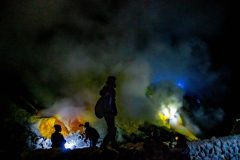
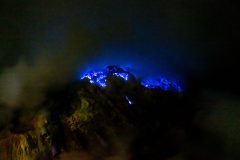
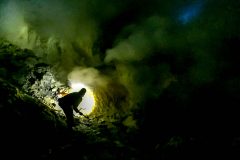
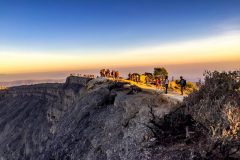
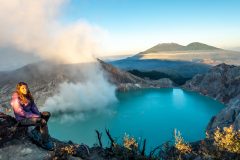
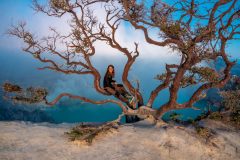
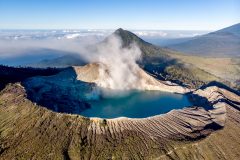
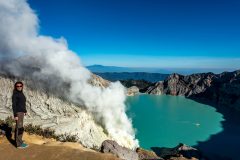
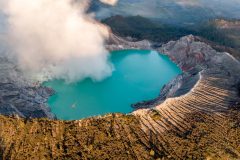
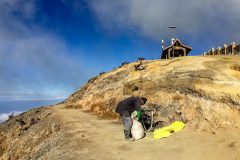
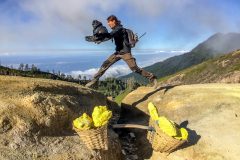
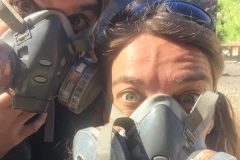
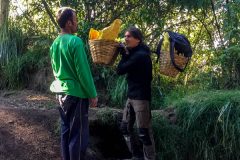
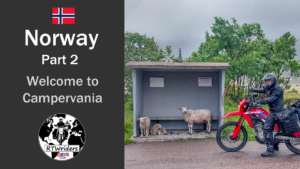
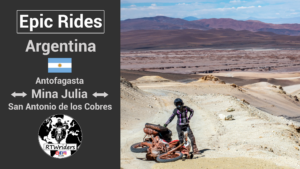
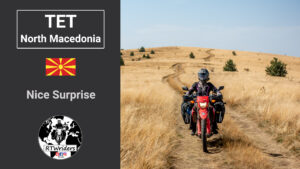

Looks fantastic, I’ll consider doing this next time I am riding Indonesia.
You definitely should – it is really worth doing it. The area is also fantastic to ride your bike.